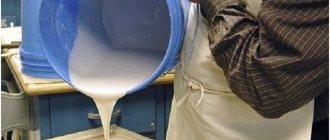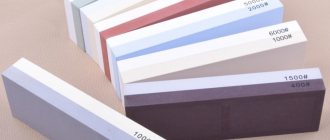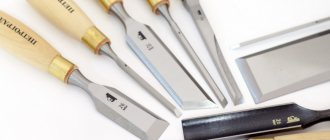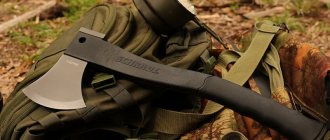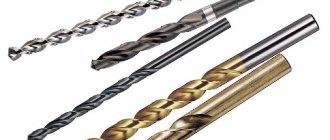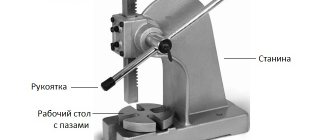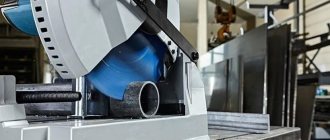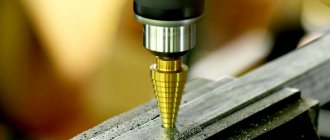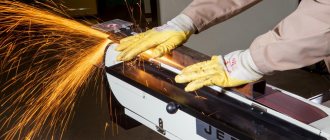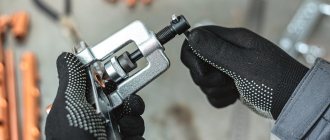Wheels for sharpening tools are not only abrasive (read about vulcanite wheels). Of course, most often these are the ones that are used on sandpapers, since they fulfill the owner’s requirements without any problems. Sharpening a kitchen knife or scissors is no problem. However, there are other types - diamond.
They are also suitable for sharpening home tools, but for a finer finish. It will not be possible to sharpen an ax with such a circle, its grain is too fine. So, diamond wheels are used for sharpening tools; they are used to sharpen hard alloys (brazing on drill bits for a hammer drill, brazing on drills and circular saws for a circular saw).
As you can see, the scope of application is quite large. The advantages of such circles are that they practically do not wear out, one circle lasts for a year or more (depending on the frequency of use). When I was a stone engraver, we used a diamond cup mounted on emery to sharpen pobedite cutters (to cut out patterns on granite) - it lasted for 3 years of use (and we sharpened cutters made of P18 steel every day).
Let's look at the classification of diamond wheels, how to choose the right one, and what to pay attention to. The first is the shape, there are 3 types - cup, plate and straight profile.
Diamond cup. Marking 12A245(deep)
In general, the markings of the wheels contain many numbers, including the width of the diamond layer and its thickness, and the fit (the diameter of the internal hole). The thicker the diamond layer, the more expensive the sharpening disc. For example, sharpening cup 12A245 150*40*10*3*32 125/100 - this means a cup with a diameter of 150 mm, depth 40 mm, thickness of the diamond layer - 10 mm, its thickness - 3 mm, fit - 32 mm (standard). 125/100 mm - diamond grain size (read below).
This thing is perfect for sharpening tools (soldering tips, cutters, knives, etc.).
Shallow plate. Marking 12A220
In appearance, the plate differs noticeably from the cup in depth; as a rule, the height is only 18 mm. In the other everything is standard, diamond grinding wheel 12A220 150*10*2*18*32 160/125 - plate with a diameter of 150 mm, width of the diamond layer 10 mm, thickness 2 mm, depth - 18 mm (shallow), fit 32 mm. Grain 165/100 is quite coarse compared to others.
Plates come in 150 mm and 125 mm diameters.
They are excellent for sharpening tools; moreover, they can be used to sharpen carbide tips on circular saws. In order to sharpen such tips, you will need a thin plate so that the edge can fit between the teeth.
Other types of grinding wheels
In wood and metal processing, a flap grinding wheel is often
used .
This type of equipment differs in design, in which the working surface is divided into segments. This allows for maximum efficiency in cleaning weld seams or edges, removing rust, scale and burrs, as well as during surface preparation for painting.
The flap grinding wheel has a long service life, and the surface wears evenly. This allows the equipment to be used until it is completely worn out. In addition, the flap grinding wheel maintains a constant rotation speed and operates without noise or vibration.
The grain size of grinding wheels and their dimensions are determined by GOST.
The choice of suitable equipment depends on the parameters of the angle grinder, machine and any other tool, as well as on the physical characteristics of the consumable.
The most widely used grinding wheels are the following
sizes : 115, 125, 180, 230 mm.
The 150 mm grinding wheel can be made of any abrasive and, as a rule, is used in the finishing of parts. In addition, this size of equipment is considered optimal for working at medium speed. Craftsmen consider the 150 mm grinding wheel convenient for processing the surfaces of round workpieces with a diameter of up to 1100 mm. Smaller equipment is used for working with small parts.
The 125 mm grinding wheel is suitable for finishing and profiling, sharpening cutting elements and working with thin-walled parts. Equipment of this size often features secure fastening and a solid base. In addition, a 125 mm grinding wheel is often used for processing wooden workpieces. Thanks to the holes, such a working element quickly removes dust.
Whatever the diameter of the wheel, it is important to pay attention to the characteristics of the grinding tool. Tooling must be compatible with the device to ensure surface treatment remains as efficient as possible.
Grain
Circles are small, medium and large, however, the grain is indicated by 2 numbers at once through a fraction.
- 200/160 - the largest
- 165/100 - large
- 125/100 - average
- 100/80 - fine-grained
The largest diamond grain is used where it is necessary to remove a layer of metal noticeably. For example, to align the cutting part of a knife. Large ones are also used. Medium grain - for fine-tuning the cutting part, to give the ideal sharpness. Fine - for final finishing - suitable for sharpening knives as a blade.
Also in the marking you can see the value AC4. AS - synthetic diamond. Most often, such circles are made from it, so you shouldn’t bother too much.
Conclusion - “diamonds” are excellent for sharpening tools, most often they are hard alloys and hard tool steels (P18, P9, steel with cobalt R6M5K5 and others). In addition to this, you can sharpen knives and other household tools, although then it is better to take a larger grain (at least 165/100), otherwise if you buy a wheel with 100/80 grain for your home, you will not be able to sharpen anything on it, it is so fine , will only remove microns that are invisible to the eye.
Electrical equipment, light, lighting
0 votes
+
Vote for!
—
Vote against!
Many of us have gardens, vegetable gardens, we all use knives, scissors, chisels, drills, and we often have to sharpen garden tools, be it an ax or a shovel. In order not to spend a long time with sharpening by hand, you need to buy a special machine, which is called household emery. How to choose the right device, and what is recommended to pay attention to? Let's look into this issue now.
- Circle diameter
What is household emery
Emery is a black-green or green-colored rock used as an abrasive material, a mixture of magnetite and corundum. The highest quality emery is mined in Naxos, Galeika, Turkey and Greece. The peculiarity of emery as an abrasive material lies in the presence of fusible impurities, so it can only be used in products that do not require high temperatures for production, that is, on a cold bond.
An important indicator of emery is its abrasive ability, which depends on the corundum content in the rock. The highest corundum content is observed in chloritoid ores, but is 2-3 times lower than in very high-quality corundum ores. As a non-slip element, emery is most widely used for finishing floors, sidewalks and staircases.
A sharpening machine (emery) is a power tool designed for sharpening metal: drills, knives, axes, chisels and scissors, as well as saw blades. The main part of the sharpener body is occupied by an electric motor with a support, which is attached to the workbench using fasteners. The power supply of the device is turned on and off using a special button.
On both sides of the engine, 2 abrasive wheels are placed parallel to each other: one wheel with large grain sizes is intended for rough processing of the material, the other fine-grained one will be needed for fine processing. Abrasive wheels most often have a diameter of 150-250 millimeters and a thickness of 16-32 millimeters. They are partially located in a protective casing. The open part of the circle rotates from top to bottom. The object being sharpened rests on a special stand, the distance from it to the sharpening wheel can be adjusted, and it also rotates towards the wheel at a certain angle.
There are models of electric sharpeners that have a metal disk brush instead of one wheel for preliminary rough processing of the object. Also, some models have additional special slots for drills. To protect against sparks, a special transparent plate called a tap is installed on the electric sharpener. Also, some sharpeners are additionally equipped with a lamp to illuminate the working area of the sharpener.
The very effect of electric emery is that part of the material is removed from the surface being treated. The material usually has a crystalline structure, which wears out during operation in such a way that the smallest particles break off from it, and in their place completely new sharp edges appear, and all due to fragility.
What types of sharpeners are there?
The sharpeners on sale are divided into three classes: professional, semi-professional and household. Their main difference is reliability, which is ensured by the use of certain materials. The household tool is designed for two hours of daily use. Professional sharpeners are designed for constant daily work for 8 hours with mandatory 2 breaks, each 15 minutes. Semi-professional machines, of course, occupy an intermediate position between these two classes.
Also, each class has a wide selection of different designs and modifications of sharpening tools. Of course, these are not only ordinary machines with two circles of various diameters, but also with a non-standard arrangement of circles, for example, placed perpendicular to each other. The most versatile machine is one that is equipped with a sanding belt and a regular disc.
For home needs, a fairly inexpensive sharpener with low speeds is enough - about 120-150 revolutions per minute and a circle that is immersed in a bath of water, that is, “wet”, on which you can slowly give the required sharpness to the cutting and piercing tools in the house quite safely subjects. Such a small emery machine runs on AC power; grinding wheels with an outer diameter ranging from 150 to 200 millimeters and an average thickness of 20 to 40 millimeters are used as an abrasive tool.
There are also models that have an additional brush disk located on one side, most often on the right. It is intended for workpieces that have never been used as a cutting object. First, such a product is cleaned using a brush disk, that is, it is roughly sharpened, and then brought to the desired condition on a grinding wheel with fine grain. A brush disk is also used to remove rust or remove small nicks that remain on the metal after sharpening.
Various metal tools are sharpened on household machines with 2 wheels. But not all models have special slots designed for drills. Some companies are abandoning them to reduce the cost of their products. Also, such grooves are not provided on sharpeners with large disks, which are designed for sharpening thick and large tools, that is, axes and other similar tools.
The induction motors used in modern sharpeners do not require special maintenance and operate quietly. On almost all products, the rotor axis is mounted on ball bearings. Reliability of fastening of grinding wheels, as a rule, is ensured by a regular standard nut.
There are also sharpeners on sale equipped with a sanding belt instead of a second abrasive wheel, which greatly expands the possibilities of using the machine. During operation, the belt moves along with the wheel. This means that with such a belt emery you can not only sharpen all kinds of metal workpieces, but also grind them. If mainly only the sharpening machine is used, then the belt is wasted. Therefore, when there is no need for it, then you need to think about the advisability of buying such a machine for your home, or remove the tape from the sharpener when it is not needed.
Classification of grinding wheels
If you decide to buy an electric sharpener, you need to familiarize yourself with the classification of abrasive wheels for emery. Let's look at which of them are the most popular.
Grinding wheels 25A
Grinding wheels made of electrocorundum are the most popular because they are designed mainly for processing softer metals, that is, they are ideal for home use. This circle is perfect for sharpening axes, scissors, as well as for processing ordinary steel (angles and other products). Most often, electrocorundum circles are white and marked 25 A. It happens that manufacturers add coloring elements, so the circles can be orange or blue.
On such a wheel, when turning ordinary metal, a fairly high-quality sharpening is obtained, because the composition of the wheel is quite soft, during friction the temperature is low, because of this blue scale does not appear on the metal, and if it is not there, then the metal retains its properties perfectly. And this applies, first of all, to cutting objects, for example, knives, because it is quite important not to overheat the metal when sharpening. Therefore, an alumina grinding wheel is an excellent choice for the home.
Before you choose an emery blade, you need to remember that wheels come in different sizes and are designed for different sharpeners. If you buy a circle for home emery, the fit is most often 32 millimeters. The most common sizes of a circle are 200, 175, 150, 125 millimeters in diameter, thickness - 25, 20, 16, 10 millimeters, and fit - 32 millimeters.
Grinding wheels 64C
Green-colored silicon carbide grinding wheels are designed for processing hard alloys (brazing on rotary hammer drills) and tool steel. This material has an increased resistance to abrasion; when sharpening, the temperature is quite high, so if you try to sharpen a home kitchen knife with this circle, then, of course, you will ruin it due to the instantaneous appearance of scale on the knife blade.
This wheel is usually used only for sharpening tools made of special tool steel (P18, P6M6, with the addition of cobalt to steel and hard alloys T15K10, T15K6, BK8). It is not very convenient to sharpen hard alloys, so it is necessary to use the finest grain of an abrasive wheel, but still the best option is to sharpen hard alloys with diamond emery. The marking of such a circle is 64C, and the dimensions are exactly the same as those of electrocorundum.
Vulcanite-based circles
These wheels contain vulcanized rubber with abrasive additives. The most commonly used abrasive is A4 electrocorundum. It is impossible to remove a lot of material on such wheels; they are intended for final processing, removing rust, minimizing burns, as well as removing possible burrs and adding shine.
Volcanic bond emery wheels are manufactured for grinding minerals and metals with a maximum operating speed of 60 m/s. The diameters of the circles are as follows: 125 millimeters, 150 millimeters, 175 millimeters; they are abrasive tools that wear out quite quickly.
Characteristics of electric emery
The shape of abrasive wheels comes in the form of a plate, a cup and a regular straight line. It is recommended to choose it according to the nature of the work performed, as well as depending on the very shape of the workpiece that you will sharpen on the sharpener. The regular straight profile is most often used for many sharpening jobs. There are also special sharpening wheels for sale for saws, the edges of which are made at an angle for ease of sharpening the saw between the teeth.
Circle diameter
Each sandpaper has characteristics such as the diameter and power of the grinding wheel. These parameters are interrelated, that is, the larger the diameter of the abrasive wheel, the more powerful the motor is needed. Let's take a closer look at them.
The diameter of the circle can be large - 200 millimeters, medium - 150-175 millimeters and small - 125 millimeters. Of course, everything depends on the nature of the work being performed. For example, to sharpen a shovel or an ax you need to have stronger emery, so that the diameter is at least 175-200 millimeters, and for sharpening kitchen knives, sandpaper with a circle diameter of 125 millimeters is suitable.
It should be noted that for everyday use, in addition to small circles, they also produce circles that have a larger diameter and are placed on large machines. These circles have fits of 76 mm, 127 mm and 203 mm, and diameters reach 250 mm, 300 mm, 350 mm and 400 mm. These are expensive, large and heavy wheels designed for production.
Power
The more power an electric sharpener has, the harder and coarser materials can be used on it. The household models available for sale have very different power consumption, but on average it is 150-250 W. There are also models with a power of 120 W, and the highest power of a suspended emery can be 400 W.
When sharpening a shovel or an ax, you need to press harder on the wheel than when sharpening a knife, since a low-power engine cannot cope with such a task: if you press hard, the wheel will stop, and this will have a bad effect on its service life. From this it is clear that the larger and heavier the part, the more powerful the sharpening machine is needed.
Planting emery
The seat of the emery is the inner hole of its grinding wheel. At the moment, several specific planting standards are known. The most common fit is 32 millimeters; it is very easy to find an abrasive wheel with this internal diameter. There are also sharpening wheels with a fit of 20 millimeters, 12.7 millimeters and 16 millimeters, which are less common on sale.
The emery must be secured to the table before starting work; mounting bolts are included in the kit so that the emery does not “ride” on the table while working. It would also be a good idea to install the protection included in the kit. To avoid eye injuries, you need to wear special safety glasses. The workpiece must be brought to the rotating grinding wheel only at an acute angle, otherwise the workpiece may be torn out of your hands.
Circle grain
Many people, when purchasing sanding wheels, do not know how the grit is marked. The grain of grinding wheels can be marked 40, 25, 16, 12, 8. The largest is 40, and the smallest is 8. Also, in addition to the numbers, there may be the letters CM, which means a medium-soft wheel, which is not too expensive and is widely used very popular among buyers. It is a little less common to see ST grain (medium-hard wheel) on sale; its cost is noticeably higher, but its abrasion resistance is much higher.
Fine grain (12, 16) is, of course, better to take for precision sharpening. Quite often they buy wheels for sharpening skates 150 8 32 12 CM - these are wheels with a diameter of 150 millimeters, a fit of 32 millimeters, a thickness of only 8 millimeters, the grain is fine, which makes it possible to simply sharpen the tool perfectly.
For example, to install an emery wheel (150 millimeters), it is best to buy a standard SM emery wheel, that is, with a diameter of 150 millimeters, a fit of 32 millimeters, and a circle width of 20 millimeters. Wheels with 25 grit are suitable for sharpening both large tools - axes, and smaller ones - scissors, knives. A standard medium-soft circle (SM) is also suitable for use at home.
Manufacturers
Today the market is quite saturated with electric sharpeners from various manufacturers. “Kraton” and “Zubr” have proven themselves to be excellent. Judging by the reviews of these companies, they produce fairly high-quality sandpaper. You can safely purchase such emery for your household.
Now you know which sandpaper to choose for home use. First, decide which products you will mainly sharpen, then pay attention to the power of the device. Don’t forget to take a closer look at the abrasive wheels, because they have different diameters, thicknesses, fits and grits, and therefore each of them is used in separate situations.
2 Device for sharpening turning tools
Sharpening tools involves not only wheels, but also the use of additional devices - boring machines.
Jig boring machines bore, drill, countersink, cut internal and external threads, grind cylindrical surfaces and trim ends.
Tool sharpening machine
A distinctive feature of the machines is a horizontal (or vertical) spindle, which makes axial feed movements. The necessary tool is fixed into the spindle hole - a boring bar with a cutter, a reamer, a drill, a milling cutter, etc.
- horizontal boring;
- coordinate boring;
- diamond boring;
- vertical boring.
Specialized models of jig boring machines:
- Jig boring machine 2D450.
- Jig boring machine 2V440A.
- Jig boring machine 2431.
- Jig boring machine 2421.
2.1 Sharpening technology
- Main back surface.
- Auxiliary back surface.
- Front surface.
- The radius of curvature of the ring.
At the end, the sharpening angles are checked using a template.
Types of sharpening of cutters
To obtain an even and smooth edge, the tool must be constantly in motion along the grinding surface. With this kind of work, the circles will last longer.
The tool can be processed dry or with water. The flow of water must be sufficient and continuous. A dry tool should not be immersed in water, as this may cause destruction of the working edge.
- fine-grained whetstone (technical oil is also used);
- copper wheel (boron carbide paste and technical oil are also used).
Finishing can only be done on cutting tools (edge width up to 3mm).
2.2 Safety precautions
- Do not use grinding wheels whose operation is accompanied by beating.
- The tool rest should be securely fixed closer to the circle.
- Use a tool rest to support the cutter.
- Do not press the cutter too hard (uneven heating can cause cracks; under high pressure the wheel can quickly deteriorate).
- Do not sharpen without a protective guard.
- Wear safety glasses.
- The workplace must have local ventilation.
Type of grinding wheel bundle
The abrasive material is a key selection criterion.
A certain type of binder is used as a basis for the adhesion of grains bakelite, vulcanite or ceramic.
Each of them is designed to perform specific tasks.
A grinding wheel for an angle grinder
with a bakelite bond is used when working with metal.
This type of equipment is designed for carving or grinding at high speed. However, a grinding wheel with a bakelite bond quickly overheats. Therefore, it is recommended to use this nozzle only if the operating temperature does not exceed 300°C.
Working elements with
vulcanite bond are used for polishing and finishing.
This equipment also cannot withstand high temperatures and is used for cutting work at low temperatures.
An abrasive grinding wheel
with a ceramic bond is more resistant to high temperatures.
It is permissible to use various lubricants and coolants during operation. This equipment can withstand speeds of up to 65 m/s, however, thin circles are not resistant to lateral loads.
The type of abrasive compound is indicated by the following markings:
- V, ceramic;
- B, on synthetic resins;
- BF, glass fiber reinforced synthetic resins;
- B4, bakelite with graphite filler.
